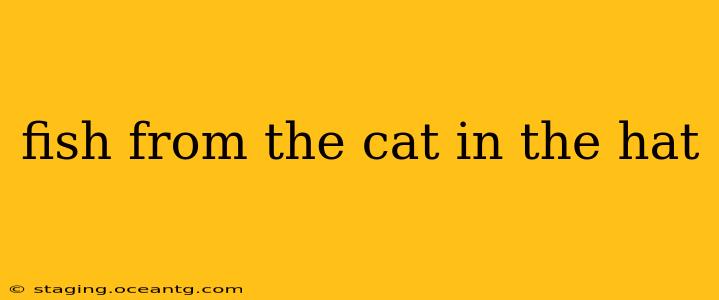Dr. Seuss's The Cat in the Hat is a beloved children's classic, instantly recognizable for its whimsical illustrations and playful rhymes. But beyond the simple story of two bored children and a mischievous feline, lies a world of hidden meanings, literary devices, and surprisingly, a lot of discussion about the fish! Let's explore the enduring impact of this seemingly simple character and uncover some fascinating facts.
What Kind of Fish is in The Cat in the Hat?
This is a question that has sparked debate among Seuss enthusiasts! The book doesn't explicitly state the fish's species. The illustrations depict a small, goldfish-like creature, orange with a simple design. Many readers assume it's a goldfish, due to the commonality of goldfish as pets. However, the ambiguity allows for imaginative interpretation, and ultimately, it doesn't truly matter what species it is—it's the fish's personality and role in the story that counts.
Why is the Fish so Important in The Cat in the Hat?
The fish acts as the voice of reason and authority, a stark contrast to the chaos unleashed by the Cat. He represents the adult perspective, cautioning against impulsive behavior and upholding rules and order. His warnings, often ignored, highlight the children's temptation to rebel against routine and embrace the thrill of the unexpected. This small, seemingly insignificant character plays a crucial role in shaping the narrative's moral compass.
What does the Fish symbolize in The Cat in the Hat?
The fish's role extends beyond simple caution. He symbolizes responsibility, consequence, and the importance of rules. He serves as a reminder that actions have repercussions, even seemingly harmless fun can lead to consequences, and that authority figures, even if perceived as restrictive, often have valid concerns. He represents the adult world's attempt to manage the chaos and unpredictability of childhood.
Is the Fish a good or bad character?
The fish is neither purely good nor bad. He's a realistic portrayal of a responsible adult figure attempting to maintain order amidst chaos. His judgmental nature might appear harsh to young readers, but it underscores the necessity of boundaries and consequences. He's not a villain, but rather a character representing the often-conflicting world of adults versus children's desires for adventure.
What happens to the fish at the end of the book?
At the end of the story, the Cat and his chaos disappear, leaving the children and the fish back in their normal routine. The fish is left unharmed, a testament to the story's ultimate message of restoration and the return to order. His presence at the end underscores the enduring importance of responsibility and the reassurance that even amidst chaos, normality can be restored.
The Enduring Legacy of the Fish in The Cat in the Hat:
The fish, despite not having many lines, plays a vital role in the book's success. He’s a memorable character, representing a classic adult perspective that resonates with readers of all ages. His understated presence and simple warnings create a lasting impact, solidifying the book's message about responsibility and consequences in a way that's both entertaining and thought-provoking. He perfectly encapsulates the subtle complexities hidden within Dr. Seuss's deceptively simple storytelling.
